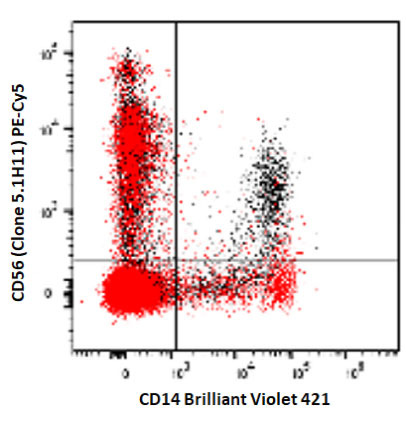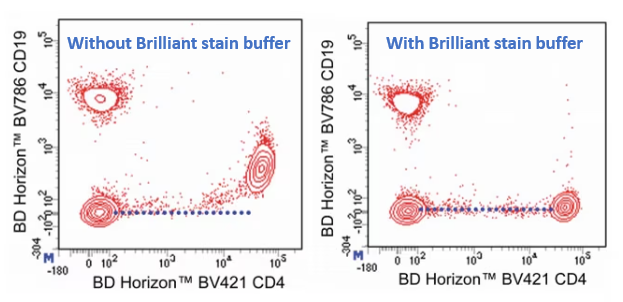Dye-mediated Binding
Unspecific antibody binding to non-target cells (and plastic surfaces) is commonly minimized by including excess irrelevant protein (BSA or dilute serum) in the staining buffer. Furthermore, specific blocking reagents can be used prior to staining to eliminate antibody binding to Fc receptors. Unfortunately, neither of these strategies are effective in eliminating dye-mediated unspecific binding. This type of background staining shows up in two main flavors: 1) cyanine dye binding to monocytes/macrophages, and 2) polymer dye interactions.
Cyanine Dyes
Some traditional tandem dyes with cyanine acceptors (such as PE-Cy5, PE-Cy7, PerCP-Cy5.5, APC-Cy7) show unspecific binding to monocytes and macrophages. However, similar monocyte binding has also been observed with non-cyanine dye PE/Dazzle594 so the exact mechanism is poorly understood although the high affinity Fcγ1 receptor (CD64) is often implicated as a target. Many vendors sell their own proprietary staining buffers to eliminate this type of unspecific binding (Fig. 1.).

Fig. 1. True-Stain Monocyte Blocker™ treatment (red) eliminated unspecific PE-Cy5 binding (black) to CD14 positive fraction of human PBMCs. Original image in the technical data sheet.
Polymer Dyes
The second type of dye-mediated binding also relates to a specific group of (mostly tandem) dyes but is independent of the stained cells, i.e. it is due to the dye-dye interactions between different polymer dyes (BD Horizon Brilliant™ and Super Bright). Again, there are multiple proprietary buffers commercially available to eliminate the staining artifacts (Fig. 2.).

Fig. 2. BD Horizon™ Brilliant Stain Buffer eliminated the unspecific binding between the BV605 and BV421 polymer dyes. Dotted line added to visualize the effect within the CD4 positive lymphocytes. Original image in the technical data sheet.
Additional Information:
- Jahrsdörfer et al. (2005) Phosphorothyoate oligodeoxynucleotides block nonspecific binding of Cy5 conjugates to monocytes. J Immunol Methods 297: 259-263, doi: 10.1016/j.jim.2004.11.023
- Brilliant Stain Buffer technical data sheet, https://www.bdbiosciences.com/content/bdb/paths/generate-tds-document.us.563794.pdf
- Super Bright Staining Buffer manual, http://assets.thermofisher.com/TFS-Assets/LSG/manuals/SuperBrightStainingBuffer.pdf